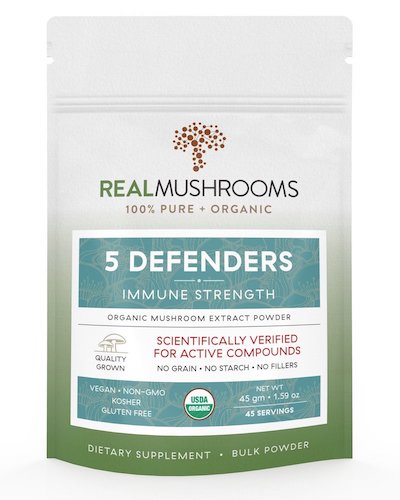
Real Mushrooms 5 Defenders is a blend of 5 types of mushrooms that have clinical evidence for boosting immunity and energy. Here we’ll examine its properties and effects.
Disclosure: Some of the links on this page are referral links. At no additional cost to you, if you choose to make a purchase after clicking through those links, I will receive a small commission. This allows me to continue producing high-quality, ad-free content on this site and pays for the occasional cup of coffee. I have first-hand experience with every product or service I recommend, and I recommend them because I genuinely believe they are useful, not because of the commission I get if you decide to purchase through my links. Read more here.
In a hurry? Here are the highlights:
- 5 Defenders is a blend of 5 types of medicinal mushrooms from Real Mushrooms.
- The 5 types of mushrooms in 5 Defenders are Chaga, Reishi, Shiitake, Turkey Tail, and Maitake.
- The mushrooms in 5 Defenders have clinical evidence for boosting immunity and energy.
- 5 Defenders uses only real whole mushroom fruiting bodies; no added grain, filler, or mycelium here.
- 5 Defenders is analytically tested and verified for beta-glucan content. It is guaranteed to have at least 20% beta-glucans and less than 5% starch (alpha-glucans in the form of glucose).
- 5 Defenders is USDA certified organic, certified kosher, gluten-free, non-GMO, and vegan.
- 5 Defenders is available in powder or capsule form.
Use code OPTIMIZE at checkout for 10% off.
Contents
What is 5 Defenders Mushroom Extract Powder?
5 Defenders is an organic mushroom extract supplement from Real Mushrooms. It is certified organic, certified kosher, gluten-free, non-GMO, and vegan. 5 Defenders is comprised of the following 5 mushrooms:
- Chaga (Inonotus obliquus)
- Reishi (Ganoderma lingzhi)
- Turkey Tail (Trametes versicolor)
- Shiitake (Lentinula edodes)
- Maitake (Grifola frondosa)
Here’s the nutrition label:
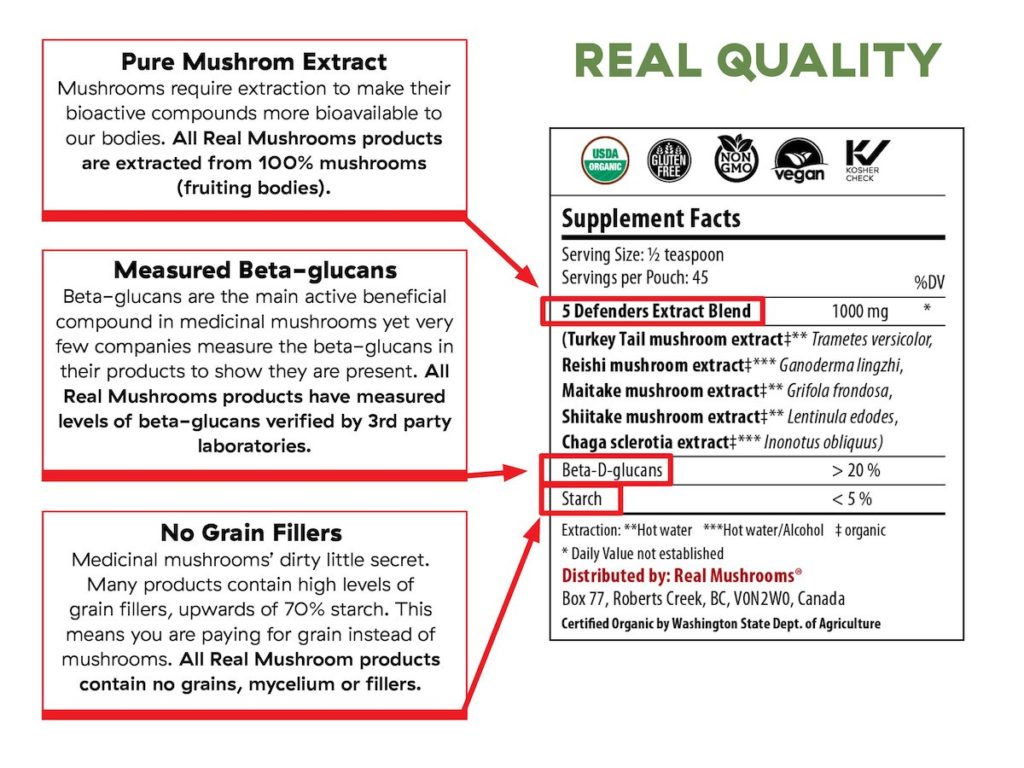
Benefits of 5 Defenders Mushroom Extract Powder
In summary, 5 Defenders should boost immunity and energy levels. Clinical evidence abounds for all the mushrooms in 5 Defenders in terms of their antioxidant, pro-cardiovascular, prebiotic, anticancer, immunomodulating, anti-inflammatory, antimicrobial, antineurodegenerative, and antidiabetic properties. Let’s briefly look at each mushroom specifically.
Chaga
Chaga (Inonotus obliquus) is one of the most potent antioxidants in the world, and is rich in a variety of vitamins, minerals, and nutrients1. It has been used historically to support immune function and liver health2,3. It also appears to lower blood sugar4,5. Recent research on Chaga has been focused around its potential anti-cancer properties6–9.
Reishi
Reishi (Ganoderma lingzhi) is referred to as “the mushroom of immortality.” It is praised for its support of the immune system and its ability to improve sleep and reduce stress by promoting calmness via GABAergic effects10–12. It is a potent immunomodulator13,14. As with Chaga, much of the recent research on Reishi has been devoted to investigating its anti-cancer properties15–19.
Shiitake
Shiitake (Lentinula edodes) is famous for its meaty flavor and extensive use in Asian cooking. Its primary benefits appear to be its immunity and liver support properties. Like the rest of these mushrooms, it is studied for its anti-cancer and immunomodulatory effects20–22.
Turkey Tail
Turkey Tail (Trametes versicolor) is a potent immune booster, so much so that it is an approved cancer drug called PSK (Polysaccharide K) in Japan, and has been used as an adjuvant therapy since the 1970’s23–26.
Maitake
The Maitake (Grifola frondosa) mushroom is commonly known as “Hen of the Woods.” Like the Turkey Tail mushroom, its primary use seems to be as an immunomodulator, activating white blood cells. Also like Turkey Tail and others, it is studied primarily for its anti-cancer benefits27,28.
Whole Fruiting Body vs. Mycelium on Grain — Know What You’re Getting

A fully developed mushroom at the end of its lifecycle is known as a “whole fruiting body.” It’s what you picture when you think of a mushroom. Most people perhaps don’t realize that many “mushroom” supplements out there may contain little to no actual mushrooms at all. They are instead selling you what’s known as myceliated grain, near the beginning stage of a mushroom’s lifecycle.
Think of mycelium as a seed from which a mushroom later grows. Mushroom growers actually use mycelium as seeds which are put on some form of carrier material (usually grains like wheat or rice). It’s a linguistic sleight of hand on many supplement labels that is actually against FDA regulations. “Mushrooms” from some companies could still just mean myceliated grain. Compounding this problem is the fact that the research out there on mycelium is using pure mycelium, not myceliated grain.
To briefly walk you through the process, grains can be put in autoclavable bags for sterilization, after which they’re innoculated with mycelia culture. The bags are then incubated, during which stage the mycelium will colonize the grain, at which point it’s referred to as “grain spawn” or “mycelium on grain” (MOG).
This “mycelium on grain” would usually then go to a mushroom grower to continue its lifecycle into a whole fruiting body (the real mushroom). Unfortunately, many suppliers stop at this stage and simply sell you the milled grain, with a little bit of mycelium, as a nutritional supplement. The benefit for these companies is of course that the aforementioned process is very scalable and allows for mycelium to be grown and colonized quickly and cheaply in a lab from anywhere in the world.
Cheap and efficient sounds great, though, right? Wrong. The problem for the consumer is that these milled mycelium-on-grain powders contain little, if any, of the bioactive compounds (beta-glucans, triterpenoids, ergosterol, etc.) that are responsible for the benefits above. You are buying mostly grain. As you might imagine, myceliated grain products have a very different taste and smell than real mushrooms (whole fruiting bodies). The former is usually a muted beige color with a taste not unlike breakfast cereal (this makes sense, as it’s mostly grain). The latter, depending on the specific mushroom(s) used, will almost always be a vibrant brown powder with a rich aroma and taste.
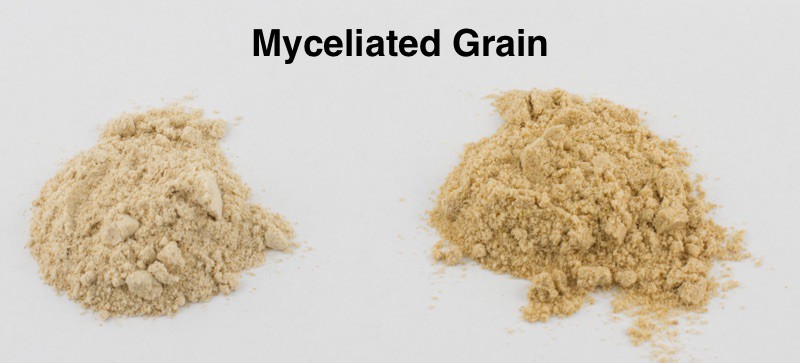
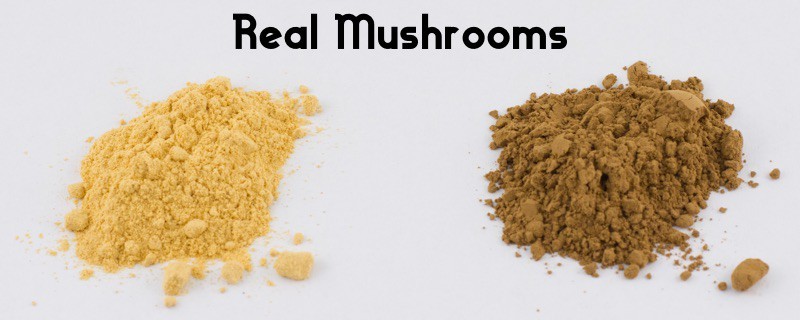
Nammex (North American Medicinal Mushroom Extracts), the gold standard of organic mushroom suppliers and pioneers in mushroom growing, research, and supplementation, prides itself on only using 100% whole fruiting bodies. The mushrooms in 5 Defenders come from Nammex, so you can rest assured that you’re getting 100% organic whole fruiting bodies (real mushrooms), with analytically-tested and guaranteed bioactive compound content.
Jeff Chilton, President of Nammex, explains these processes and concepts in the video below.
Click for Transcript
Hi, my name is Jeff Chilton and I’m the president of Nammex – North American Medicinal Mushroom Extracts. I’d like to talk to you today about the difference between mushrooms and mycelium, and this is a very important subject because if you want to get the most health benefits from your mushroom product, you really need to pay careful attention to the form of the product and how it’s produced. I’m in a greenhouse right now that’s growing Shiitake mushrooms and these mushrooms are being grown on sawdust logs. A mushroom is actually called a fruiting body, and it’s just one stage of a fungal organism that’s called a basidiomycete and there’s actually a number of different stages and that’s what we want to talk about today is the different stages of this basidiomycete organism.
This is a diagram of the basidiomycete lifecycle. In the top center are spores which germinate into hyphae and the hyphae will fuse together and form a large network called mycelium. And this mycelium is actually the vegetative body of this organism and its role is to absorb enough nutrients that allow it to produce a mushroom. Now when conditions are right, a small hyphal knot will form, which develops into a primordium, and then a pinhead, a button, and the various stages of the mushroom, until it has gills that are fully developed and producing billions of spores, and at that point the life cycle is complete. If I want to grow mushrooms, the first step is to get a pure culture of mycelium and you can do that either from mushroom tissue, from spores, or oftentimes you can get a mycelial culture from a culture bank. Pure mycelium is what a mushroom grower will use as seed and this mycelium is put onto a carrier material and at that point it is called mushroom spawn. Grain is a commonly used carrier material. In this instance I have cooked some wheat grain which is sterilized, inoculated with the pure culture of mycelium, and once it has grown out and completely colonized the grain, it is now called grain spawn.
In 1979 I attended an international conference on mushroom cultivation in France, and while I was there, I visited one of the largest mushroom spawn manufacturers in the world. I’d like to just show you how they were making the spawn because it’s really an interesting process. In this particular slide, they are filling the cooked grain into autoclavable plastic bags. In the next step, they’re going to put these bags onto a rack and then that rack is going to be moved into an autoclave. And in that autoclave, the grain is going to be sterilized so that it provides an environment for the mycelium to grow unopposed. Once out of the autoclave, the bags are put on a conveyor belt and as they pass, they’re inoculated with the pure mycelium. The bags are then sealed, put back on a rack, and then they are transferred into an incubation room where the mycelium will grow out and colonize the grain. Now that the grain is completely colonized, it can be boxed and it’s ready to send out to the mushroom grower. It is now what is considered to be pure cultured grain spawn.
The manufactured grain spawn was developed by Dr. James Sinden of Penn State University in 1932 so this is a process that has been going on for almost a hundred years. And again, this is simply a very, very effective way to transfer a pure culture of mycelium into a substrate to then grow mushrooms.
Oddly enough, some companies now grow grain spawn and sell this grain spawn as a nutritional supplement. And despite the fact that in this slide it looks like there is quite a bit of mycelium, if you break that mycelium up, you will find that you still have mostly grain in this product. And so these companies that are producing mycelium on grain or grain spawn are actually primarily selling grain powder. This is Shiitake plug spawn – mycelium grown out on wooden dowels. And it’s very well grown in the left hand jar. But once you shake that jar up, the mycelium gets beaten down and you can see it’s mostly the wooden dowel that you’re left with. So this is just another example of growing mycelium on material, whether it be grain or wood. And what you’re really left with in these products is the material that the mycelium has grown on.
So what is called mycelium and sold by many companies as mushroom is actually grain spawn – a product grown in a laboratory on a sterile grain of rice. If you bought a mycelium product, just taste it. It will taste mildly sweet, kind of like breakfast cereal. These products, as you can imagine, are mostly starch. They have few, if any, of the medicinal compounds which you expected to get when you bought it. On the other hand, a mushroom product will have a distinctly mushroom-y smell and flavor. Shiitake is very aromatic and powerful smelling. So is Maitake. Reishi has a bitter flavor. The difference is night and day. And mushrooms are rich in the medicinal compounds. So when you’re looking for a mushroom product, look carefully and be aware that some products are not really mushrooms.
Nammex themselves tested commercially available products and concluded the following simple summation:
- Mushrooms contain consistently high levels of beta-glucans29.
- Mycelium on grain has consistently low levels of beta-glucans29.
A later study by McCleary et al independently corroborated and confirmed Nammex’s findings30.
Know what you’re getting. Look for mentions of “whole fruiting bodies” and “beta-glucan content.” Real Mushrooms 5 Defenders is guaranteed to have at least 20% beta-glucans.
According to RealMushrooms.com, here are some common terms that can help you spot myceliated grain products:
- US Grown (it’s too costly to grow and harvest most real mushroom species in North America)
- Mycelium
- Myceliated brown rice
- Mycelial biomass
- Organic White Milo
- Fermented
- Full spectrum
- Primordia and exocellular compounds
About Real Mushrooms and the Creators of 5 Defenders
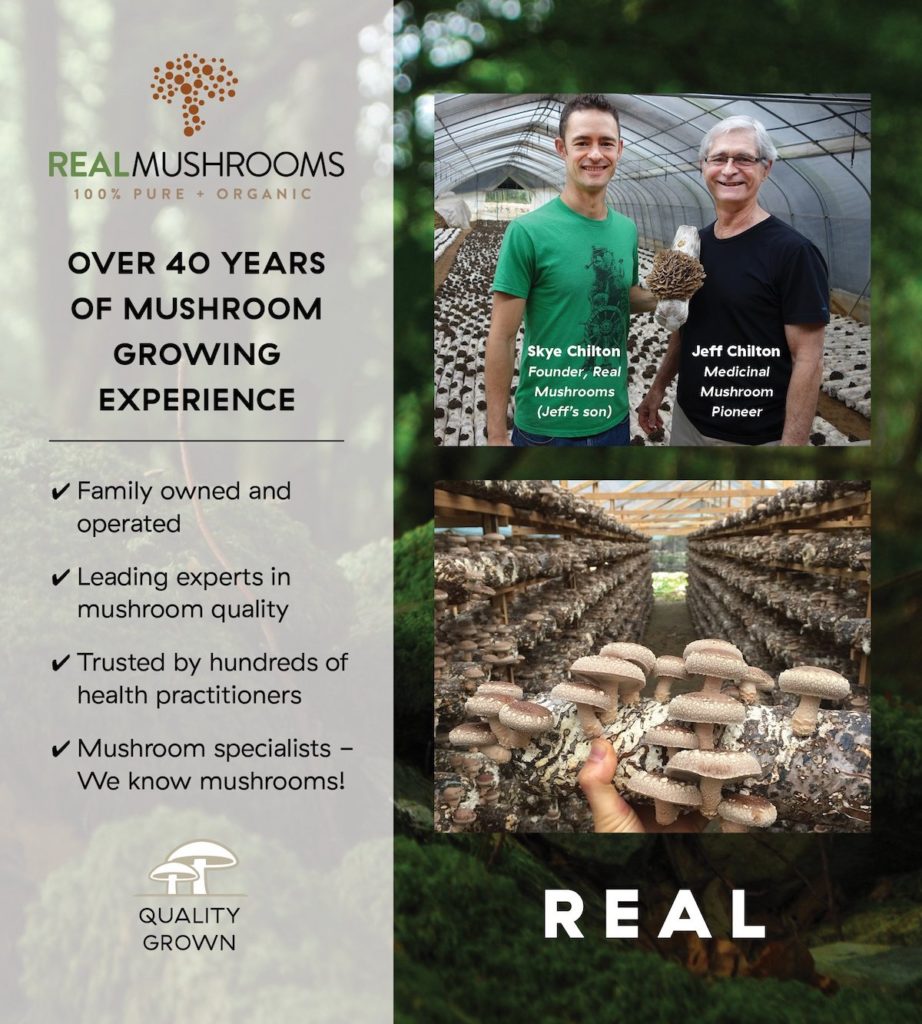
Real Mushrooms is a father-and-son team and is essentially the child company of Nammex. Jeff Chilton has over 40 years of mushroom growing experience. His son, Skye, decided to make his father’s knowledge and hard work more available to the masses via a dedicated product line, which has become Real Mushrooms.

As mentioned earlier, Nammex and Real Mushrooms are dedicated to educating the public on the myriad benefits of medicinal mushrooms and the truth and transparency about the growing and sourcing process.
Real Mushrooms 5 Defenders Review
I’ve been a fan of mushroom powders for years. Anecdotally, I can definitely feel 5 Defenders doing its thing – more mental and physical energy and better sleep. Also, knock on wood, I rarely get sick nowadays.
I actually enjoy the flavor. Most mushroom powders oddly look, smell, and taste like raw cacao/cocoa powder. Think of an earthy dark chocolate. It goes great with coffee. I don’t have a definitive before and after, but my blood biomarkers have also looked great on recent bloodwork.
You could also mix this with tea, smoothies, etc. Sometimes I’ll do an afternoon smoothie of:
- Almond milk
- Almond butter
- Unflavored protein powder
- Cocoa powder
- Banana
- 5 Defenders mushroom powder
Recommended dosage for 5 Defenders is 1g/day, which is 1/2 tsp. of the powder.
Real Mushrooms 5 Defenders Powder
You can find 5 Defenders mushroom powder from Real Mushrooms here.

Use code OPTIMIZE at checkout for 10% off!
Real Mushrooms 5 Defenders Capsules
Prefer capsules instead? You can find them here.
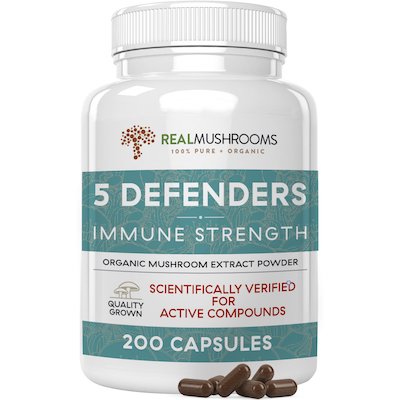
Use code OPTIMIZE at checkout for 10% off!
References
- 1.Park Y, Lee H, Jeon E, Jung H, Kang M. Chaga mushroom extract inhibits oxidative DNA damage in human lymphocytes as assessed by comet assay. Biofactors. 2004;21(1-4):109-112. doi:10.1002/biof.552210120
- 2.Nakajima Y, Sato Y, Konishi T. Antioxidant small phenolic ingredients in Inonotus obliquus (persoon) Pilat (Chaga). Chem Pharm Bull (Tokyo). 2007;55(8):1222-1226. doi:10.1248/cpb.55.1222
- 3.Kim Y, Han S, Lee H, et al. Immuno-stimulating effect of the endo-polysaccharide produced by submerged culture of Inonotus obliquus. Life Sci. 2005;77(19):2438-2456. doi:10.1016/j.lfs.2005.02.023
- 4.Xue J, Tong S, Wang Z, Liu P. Chemical Characterization and Hypoglycaemic Activities In Vitro of Two Polysaccharides from Inonotus obliquus by Submerged Culture. Molecules. 2018;23(12). doi:10.3390/molecules23123261
- 5.Wang M, Zhao Z, Zhou X, et al. Simultaneous Use of Stimulatory Agents to Enhance the Production and Hypoglycaemic Activity of Polysaccharides from Inonotus obliquus by Submerged Fermentation. Molecules. 2019;24(23). doi:10.3390/molecules24234400
- 6.Blagodatski A, Yatsunskaya M, Mikhailova V, Tiasto V, Kagansky A, Katanaev V. Medicinal mushrooms as an attractive new source of natural compounds for future cancer therapy. Oncotarget. 2018;9(49):29259-29274. doi:10.18632/oncotarget.25660
- 7.Arata S, Watanabe J, Maeda M, et al. Continuous intake of the Chaga mushroom (Inonotus obliquus) aqueous extract suppresses cancer progression and maintains body temperature in mice. Heliyon. 2016;2(5):e00111. doi:10.1016/j.heliyon.2016.e00111
- 8.Géry A, Dubreule C, André V, et al. Chaga ( Inonotus obliquus), a Future Potential Medicinal Fungus in Oncology? A Chemical Study and a Comparison of the Cytotoxicity Against Human Lung Adenocarcinoma Cells (A549) and Human Bronchial Epithelial Cells (BEAS-2B). Integr Cancer Ther. 2018;17(3):832-843. doi:10.1177/1534735418757912
- 9.Lemieszek M, Langner E, Kaczor J, et al. Anticancer effects of fraction isolated from fruiting bodies of Chaga medicinal mushroom, Inonotus obliquus (Pers.:Fr.) Pilát (Aphyllophoromycetideae): in vitro studies. Int J Med Mushrooms. 2011;13(2):131-143. doi:10.1615/intjmedmushr.v13.i2.50
- 10.Geng P, Siu K, Wang Z, Wu J. Antifatigue Functions and Mechanisms of Edible and Medicinal Mushrooms. Biomed Res Int. 2017;2017:9648496. doi:10.1155/2017/9648496
- 11.Sanodiya B, Thakur G, Baghel R, Prasad G, Bisen P. Ganoderma lucidum: a potent pharmacological macrofungus. Curr Pharm Biotechnol. 2009;10(8):717-742. doi:10.2174/138920109789978757
- 12.Cui X, Cui S, Zhang J, et al. Extract of Ganoderma lucidum prolongs sleep time in rats. J Ethnopharmacol. 2012;139(3):796-800. doi:10.1016/j.jep.2011.12.020
- 13.Mallard B, Leach D, Wohlmuth H, Tiralongo J. Synergistic immuno-modulatory activity in human macrophages of a medicinal mushroom formulation consisting of Reishi, Shiitake and Maitake. PLoS One. 2019;14(11):e0224740. doi:10.1371/journal.pone.0224740
- 14.Zhao R, Chen Q, He Y. The effect of Ganoderma lucidum extract on immunological function and identify its anti-tumor immunostimulatory activity based on the biological network. Sci Rep. 2018;8(1):12680. doi:10.1038/s41598-018-30881-0
- 15.Zhang Q, Hu Q, Xie D, et al. Ganoderma lucidum Exerts an Anticancer Effect on Human Osteosarcoma Cells via Suppressing the Wnt/β-Catenin Signaling Pathway. Integr Cancer Ther. 2019;18:1534735419890917. doi:10.1177/1534735419890917
- 16.Suarez-Arroyo I, Rosario-Acevedo R, Aguilar-Perez A, et al. Anti-tumor effects of Ganoderma lucidum (reishi) in inflammatory breast cancer in in vivo and in vitro models. PLoS One. 2013;8(2):e57431. doi:10.1371/journal.pone.0057431
- 17.Barbieri A, Quagliariello V, Del V, et al. Anticancer and Anti-Inflammatory Properties of Ganoderma lucidum Extract Effects on Melanoma and Triple-Negative Breast Cancer Treatment. Nutrients. 2017;9(3). doi:10.3390/nu9030210
- 18.Martínez-Montemayor M, Acevedo R, Otero-Franqui E, Cubano L, Dharmawardhane S. Ganoderma lucidum (Reishi) inhibits cancer cell growth and expression of key molecules in inflammatory breast cancer. Nutr Cancer. 2011;63(7):1085-1094. doi:10.1080/01635581.2011.601845
- 19.Sohretoglu D, Huang S. Ganoderma lucidum Polysaccharides as An Anti-cancer Agent. Anticancer Agents Med Chem. 2018;18(5):667-674. doi:10.2174/1871520617666171113121246
- 20.Takahashi M, Fujii G, Hamoya T, et al. Activation of NF-E2 p45-related factor-2 transcription and inhibition of intestinal tumor development by AHCC, a standardized extract of cultured Lentinula edodes mycelia. J Clin Biochem Nutr. 2019:203-208. doi:10.3164/jcbn.19-36
- 21.Mallard B, Leach DN, Wohlmuth H, Tiralongo J. Synergistic immuno-modulatory activity in human macrophages of a medicinal mushroom formulation consisting of Reishi, Shiitake and Maitake. Yu J, ed. PLoS ONE. November 2019:e0224740. doi:10.1371/journal.pone.0224740
- 22.Lee H, Lee K, Lee S, et al. Ethyl Acetate Fraction of Aqueous Extract of Lentinula edodes Inhibits Osteoclastogenesis by Suppressing NFATc1 Expression. IJMS. February 2020:1347. doi:10.3390/ijms21041347
- 23.Fisher M, Yang L. Anticancer effects and mechanisms of polysaccharide-K (PSK): implications of cancer immunotherapy. Anticancer Res. 2002;22(3):1737-1754. https://www.ncbi.nlm.nih.gov/pubmed/12168863.
- 24.Knežević A, Stajić M, Sofrenić I, et al. Antioxidative, antifungal, cytotoxic and antineurodegenerative activity of selected Trametes species from Serbia. PLoS One. 2018;13(8):e0203064. doi:10.1371/journal.pone.0203064
- 25.Benson K, Stamets P, Davis R, et al. The mycelium of the Trametes versicolor (Turkey tail) mushroom and its fermented substrate each show potent and complementary immune activating properties in vitro. BMC Complement Altern Med. 2019;19(1):342. doi:10.1186/s12906-019-2681-7
- 26.Standish L, Wenner C, Sweet E, et al. Trametes versicolor mushroom immune therapy in breast cancer. J Soc Integr Oncol. 2008;6(3):122-128. https://www.ncbi.nlm.nih.gov/pubmed/19087769.
- 27.Deng G, Lin H, Seidman A, et al. A phase I/II trial of a polysaccharide extract from Grifola frondosa (Maitake mushroom) in breast cancer patients: immunological effects. J Cancer Res Clin Oncol. 2009;135(9):1215-1221. doi:10.1007/s00432-009-0562-z
- 28.Seo Y, Patel D, Shin W, Sim W, Lee O, Lim K. Structural Elucidation and Immune-Enhancing Effects of Novel Polysaccharide from Grifola frondosa. Biomed Res Int. 2019;2019:7528609. doi:10.1155/2019/7528609
- 29.Nammex. Redefining Medicinal Mushrooms. Nammex. https://www.nammex.com/redefining-medicinal-mushrooms/.
- 30.McCleary BV, Draga A. Measurement of β-Glucan in Mushrooms and Mycelial Products. Journal of AOAC INTERNATIONAL. March 2016:364-373. doi:10.5740/jaoacint.15-0289
Medical Disclaimer: While I love diving into and extracting useful information from clinical research related to health, fitness, supplements, and more, I am in no way a medical expert. The content on this website is for informational purposes only; it is not professional medical advice, nor is it a substitute for professional medical advice. None of the statements on this website have been evaluated by the FDA. Products mentioned are not intended to diagnose, treat, cure, or prevent any disease. Read my lengthier medical disclaimer here.
Are the mushroom capsules as purse and beneficial as the powders ?